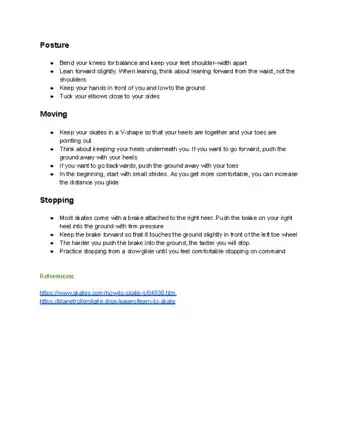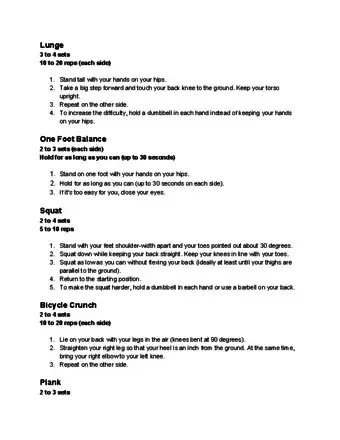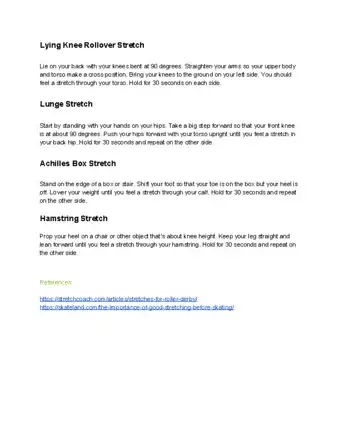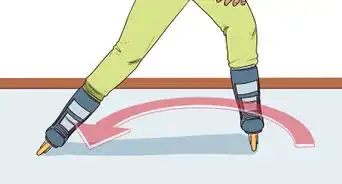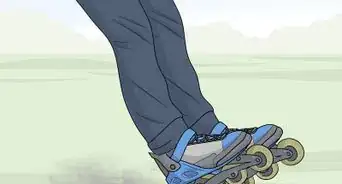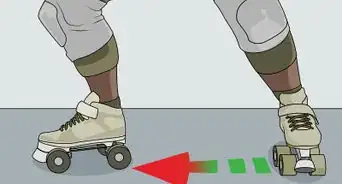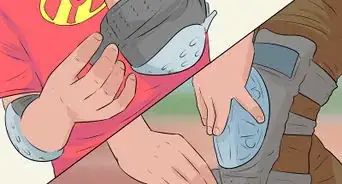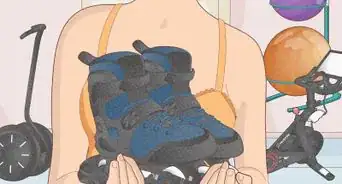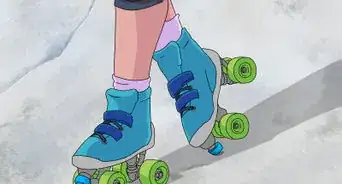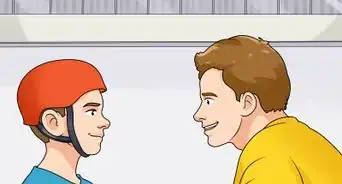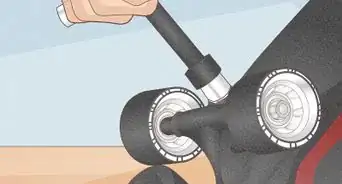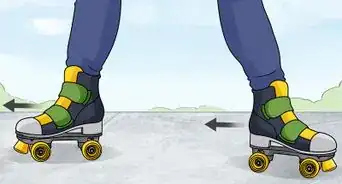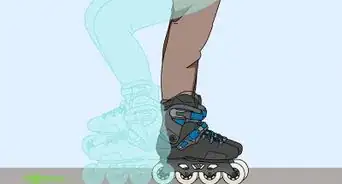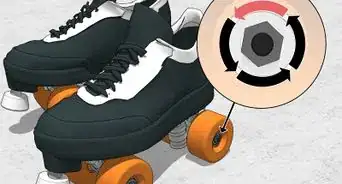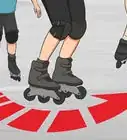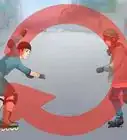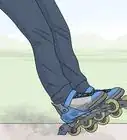wikiHow is a “wiki,” similar to Wikipedia, which means that many of our articles are co-written by multiple authors. To create this article, 84 people, some anonymous, worked to edit and improve it over time.
This article has been viewed 1,817,948 times.
Learn more...
Roller skating and rollerblading can be a fun leisure activity, a great form of exercise, a competitive sport, or a mode of transportation. Once you learn the proper stance and how to glide and stop, you'll be sailing around the rink in no time. Read on to learn the fundamentals of rollerblading or inline skating and tips on taking your skills to the next level.
Steps
Learning the Basics
-
1Put on your skating equipment. The only equipment you really need to roller skate is a pair of skates that fit you. You can buy a pair from a sporting goods store or rent a pair from any roller skating rink. Skate sizes are typically the same as standard shoe sizes. In addition to roller skates, you might want to pick up the following items:
- A helmet. Since you're just starting out, wearing a helmet may help you feel more comfortable. Everyone takes a few spills at first, and wearing a helmet will protect your head from injury.
- Knee pads and wrist guards. Your hands and knees are bound to hit the floor a few times as you learn how to roller skate. If you're concerned about getting a bit scraped up, protect yourself with knee pads and wrist guards.
-
2Assume the right posture. Place your feet shoulder width apart, bend your knees, and squat. Lower your backside toward the ground and lean slightly forward in a comfortable squatting position. When you're roller skating, balance is key, and this stance will prevent you from toppling over.
- The first time you hit the rink, you may feel like you don't have control over the skates, and you may lose your balance and fall a couple of times before you feel comfortable standing in place. This is completely normal; just keep practicing the posture until you get the hang of it.
- It's hard to stand perfectly still in a pair of roller skates. Once you've got the hang of it down, practice correcting your posture every so often by slightly moving your skates to help you keep your balance. Think about it this way: if you were standing in place without roller skates on and someone gave you a light push, you'd move your feet to regain your balance. The same idea applies when you're wearing roller skates, only it's the wheels on the skates and the pressure from your own muscles that are giving you the "push."
Advertisement -
3Walk like a duck. With your heels together and your toes pointed out, begin slowly walking forward, first the right, then to the left, then to the right, and so on.[1] Continue squatting and keep your heels directly underneath your body so you can more easily keep your balance.
- Practice until you can comfortably "duck walk" in the skates while keeping your balance. You'll probably fall down a few times at first; just get back up and remember to keep your body centered over your heels and remain in a squatting position. Try not to let your center point be on your heels. This can cause you to fall back.
- As you gain confidence, start moving more quickly and taking longer strides. Push harder on the wheels so that you roll further with each stride.
-
4Learn how to glide.[2] Lengthen each stride you take by allowing yourself to roll for awhile. Push off with one foot and glide with the other until you lose momentum, then switch your gliding foot. While you're gliding on one foot, keep the other one above the floor so that it doesn't impede your gliding.
- Practice turning right and left while gliding. When you turn right, lean your body slightly to the right. When you turn left, lean your body slightly to the left, always remaining in a squatting position.
- Glide faster. Move your legs faster and gain momentum by putting pressure on the wheels and propelling yourself forward. Practice using your body weight to help you gain speed by leaning into your strides. Use your arms to help you keep your balance and gain speed by bending them at the elbows and moving them back and forth the way you would if you were running.
-
5Practice stopping. Your right roller skate should be equipped with a brake, located on the toe of the skate. To stop, glide with your skates parallel to each other. Stay in a squatting position and lean slightly forward. Place the right skate slightly in front of the left skate, lift the toe of the right skate, and press down hard on the toe. The harder you press, the faster you'll stop.[3]
- It's important to stop with a confident thrust, rather than hesitantly touching your brake to the ground. If you don't press down hard enough on the brake, you may lose your balance and fall down.
- If you find it difficult to apply enough pressure at first, try using your hands to press down on your right knee to help you exert enough force to stop.
Trying Special Maneuvers
-
1Learn how to skate backward. When you skate forward, you propel yourself by placing your feet in a "v" shape and applying pressure to your heels. To skate backward, then, place your feet in an inverted "v" shape, this time keeping your toes together and your heels apart. Remain in a squatting position and apply pressure to your right toe with the other foot lifted, then drop your left foot and apply pressure to your left toe with the right foot lifted.e
- Since you can't see behind you and you're forced to turn around and look from time to time, it may be more difficult to keep your balance while you're skating backward. Start slowly and figure out how to turn your body to look behind you without falling down. Avoid leaning backward, as this is a common reason people fall.
- It takes practice, but eventually you'll be able to glide backward. Lengthen the strokes you take with your skates and practice rolling for awhile on one before you put the other skate down. Keep exerting pressure on your toes and making an inverted "v" shape with your feet.
-
2Do a heel-toe. In this trick, you align the skates and skate on the heel of one foot and the toe of the other. Do a few glides to gain momentum, then lift the toe of your stronger skating foot so that you're skating only on the heel, with the other foot trailing directly behind. Lift the heel of your trailing skate so that you are skating on only the heel of one skate and the toe of the other.
-
3Do a crossover turn. Start by gliding to gain some momentum. When you're ready to turn, do so by crossing one skate over the other and using it to push off in the new direction. For instance, if you're turning left, cross your right skate over your left skate, turn your body toward the left, and push off with your right skate in the left direction. Turn your shoulders in the direction you want to go, and lean into the turn to help keep your balance. Make sure to keep your knees bent a little so that you're more stable.[4]
-
4Try jumping. Do a few glides, then bring your skates together, crouch, and jump a short distance. As you gain confidence, practice jumping higher and further. You can also try a jump turn, a fancy way to change direction.
Enhancing Your Skills
-
1Practice at a rink. The best way to get better at roller skating is to practice often. Find a roller skating rink in your area and go there at least once a week so that you'll be able to build on your skills each time you go. Practice gliding, stopping, skating backward, and skating as quickly as you can. Keep practicing until you're comfortable doing turns and coming to a stop while constantly keeping your balance.
-
2Join a team or league. It's fun to roller skate on your own, but if you're up for a challenge, consider joining a league. Roller derby has become a popular sport, and most cities have a league you can sign up for. If your city doesn't have a league, consider getting a few friends together and creating your own.
- Roller hockey is another popular league-oriented style of roller skating. For this sport you'll need a pair of inline skates.
- Aggressive skating, like skateboarding, is based around doing a series of daring tricks. Make sure you have protective equipment if you try this sport.
-
3Buy skates designed to enhance your performance. There are many different types of skates to choose from, and as you start getting better at roller skating, you may want to invest in a pair of skates that will suit your specific needs and help you reach the skill level you desire.[5] Consider the following options:
- Indoor roller skates. If you like to skate indoors at a rink, consider buying your own pair of skates so you don't have to rent a pair every time.
- Outdoor roller skates. These skates have wheels designed to be durable enough to withstand tougher conditions. You can use them to skate over asphalt and other road materials.
- Speed skates. These skates are designed to go faster than typical roller skates, so consider them if you love to fly around the rink or down the street. You can buy inline speed skates, which have a row of wheels, or quads, which have two wheels on either side.
Skating Movements, Exercises, and Stretches
Community Q&A
-
QuestionHow do you skate faster?
 Community AnswerYour speed will naturally increase as you practice. Once you have good balance, you can speed up by shifting your weight back and forth between your two legs, pushing off with each foot in turn.
Community AnswerYour speed will naturally increase as you practice. Once you have good balance, you can speed up by shifting your weight back and forth between your two legs, pushing off with each foot in turn. -
QuestionHow can you skate without falling or tilting back?
 Community AnswerInstead of being rigid and scared of falling, relax and assume the 'derby' stance. Bend your knees a little and put your hands on your thighs if this gives you more support. Just practice this stance until you feel comfortable enough with this center of gravity to skate. You need to train your body to feel stable while in skates.
Community AnswerInstead of being rigid and scared of falling, relax and assume the 'derby' stance. Bend your knees a little and put your hands on your thighs if this gives you more support. Just practice this stance until you feel comfortable enough with this center of gravity to skate. You need to train your body to feel stable while in skates. -
QuestionDo you have any tips on recovering from a painful fall?
 Community AnswerIf it's a scrape, just pick yourself up and move on; the stinging ebbs after a while. If it's bleeding, put some gauze or a band-aid over it, along with some disinfectant. If it's a serious injury, such as a broken bone or heavy bleeding, go to a doctor.
Community AnswerIf it's a scrape, just pick yourself up and move on; the stinging ebbs after a while. If it's bleeding, put some gauze or a band-aid over it, along with some disinfectant. If it's a serious injury, such as a broken bone or heavy bleeding, go to a doctor.
Warnings
- Being nervous or shaky will increase your chance of falling. Have confidence!⧼thumbs_response⧽
Things You'll Need
- Roller skates
- Helmet
- Knee pads
- Wrist guards
- A good spot to skate (a driveway, wooden floor, etc.)
References
About This Article
To roller skate, first put on a helmet to protect yourself in case you fall. Then, find some flat pavement to practice on, and put on your roller skates. Stand up and keep your knees bent under your shoulders. Keep your back straight as you take a few small steps forward to find your center of gravity. Once you’re comfortable taking steps, practice taking longer strides by pushing off of one foot while extending the other out in front of you. As the foot that you’re extending lands, shift your weight to your front foot and raise your back leg off of the ground while pushing off to repeat the process. To continue gliding, keep both feet parallel and lower your back a little to gain more control over your balance. To stop, lift one foot slightly forward to make the toe stop connect with the ground. Allow the toe stop to grind against the pavement, using the friction to slow your speed. Keep practicing, and try not to get discouraged if you fall! To learn different roller skating tricks and maneuvers, scroll down!
